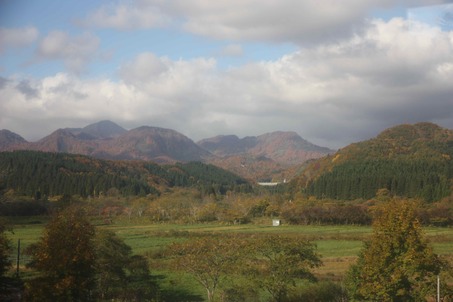
At 9:40 we were onto Hokkaido, emerging with a heavily wooded hillside area on our left as the train pulled into the station at Shiriuchi. We were back in a tunnel shortly thereafter, presumably prompted by the same engineering concerns that applied on the other side.
We were on the eastern side of the train, so it was definitely sunglasses weather as we passed what definitely looked like the in progress construction of the Hokkaido Shinkansen line, the water in the Strait was like a mill pond and it was a case of sitting back and enjoying the view for the rest of the journey.
The last stage took us on a sweeping loop around the harbour that brought Hakodate to prominence, so at this point I guess it's time for another little diversion into the world of historical and geographical background.
As the first city whose port was opened to foreign trade in 1854, Hakodate used to be the most important port in northern Japan and the largest city in Hokkaido before the Great Hakodate Fire of 1934. The city now runs third behind Sapporo and Asahikawa.
Hakodate's origins date back to 1454, when Kono Kaganokami Masamichi built a manor house in an Ainu fishing village called Usukeshi (the word for bay in Ainu). We're talking frontier lifestyle and issues with the indigenous people here, and an Ainu rebellion drove Masamichi's son, Kono Suemichi, and family out of Hakodate in 1512.
There isn't much in the way of recorded history for the next century with recurrent low level conflict between the Ainu and armed merchants like the Kono family, who set out to establish trading posts and control trade in the region. Given the frontier experience elsewhere you'd tend to assume people weren't interested in keeping records for posterity and you'd guess there wasn't a great deal of official government supervision either.
In any case there was an Ainu uprising led by a warrior called Shakushain between 1669 and 1672, that resulted in defeat and suppression for the Ainu and laid the foundations for modern Hakodate. By the nineteenth century the settlement was flourishing and there was fairly rapid development after, the Tokugawa shogunate took direct control over Hakodate in 1779. A magistracy was established in 1802.
But the big change came in 1854, when a fleet of five U.S. ships surveyed the harbour under the terms of the Convention of Kanagawa, negotiated by Commodore Matthew Perry and the port was completely opened to foreign trade on 2 June 1859 as one of five Japanese points of contact with the outside world. Visitors can see evidence of that status in the Old Foreign Quarter, which hosted several overseas consulates.
On the ground in Hakodate the first priority was, as usual, dropping the Black Monster at the hotel but there were a couple of logistical and administrative details that needed to be attended to. Madam needed to book the next batch of train tickets, and the travelling funds needed to be replenished so a rendezvous with an ATM was also a priority.